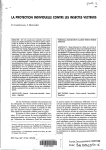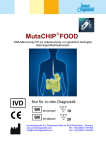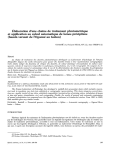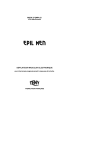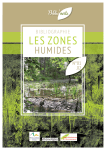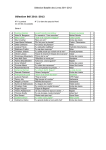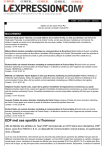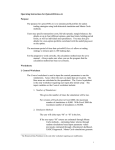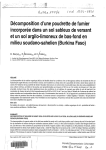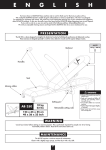Download Allozyme variation among populations of the groundnut seed
Transcript
/- 0191-9040198$3.00 + 0.00 O 1998 IClPE Insect Sci. Applic. Vol. 18,No. 1, pp. 77-86, 1998 Printed in Kenya. All rights reserved , i ALLOZYME VARIATION AMONG POPULATIONS OF THE GROUNDNUT SEED-BEETLE, CARUEDON S E ~ W S(OL.)IN SENEGAL ‘ M. SEMBENE: J.P. BR IZARD^ AND A. DE LOB EL^ Laboratoire de Protection des Stocks ITA-ORSTOM, B.P. 2765, Dakar, Sénégal; Laboratoire de Génétique et d’Amélioration des Plantes ORSTOM, B.P. 1386, Dakar, Sénégal (Accepted4 May 1998) Abstract-Starch gel electrophoresis was used to compare eight loci in six enzymatic systems of 17 samples of the groundnut seed-beetle, Caryedon serratus (01.) (Coleoptera: Bruchidae) bred on five differenthost-plant species:Arachis hypogaea, Bauhinia rufescens, Cassia sieberiana, Piliostigma reticulatum and Tumarindus indica. The rate of polymorphism was 44.8%.The average genetic diversity (Hw)was 0.184. Allozyme variability analysis indicated that seed-beetles associated with P. reticulatum and groundnut, Arachis hypogaea were genetically similar, whereas other samples clustered according to their host plant species. Geographical distances less than 400 k m were not decisive for the genetic structuring of samples associated with a given host plant. Key Words: Cayedon serratus, seed-beetle, groundnut, population, genetics, electrophoresis,allozyme variation &$amé-L‘électrophorèse sur gel d‘amidm a permis de comparer huit loci appartenant à six systèmesenzymatiques chez dix-sept échantillons delbruche de l’arachide provenant de cinq plantes hôtes différentes: Arachis hypogaea, Bauhinia rufescens, Cassia sieberiana, Piliostigma reticulatum et Tamarindus indica. Le taux de polymorphisme est de 44,8%. La diversité génétique moyenne (Hw)est de 0,184. L‘analyse de la variabilité allozymique montre que les bruches inféodées à P . reticulatum et à l’arachide sont génétiquement très proches, alors que les autres échantillons se regroupent en fonction de leur espèce hôte. Les distances géographiques inférieures à 400 km ne sont pas déterminantes dans la structuration génétique des échantillons d’une plante hôte donnée. Mots Clés: Cay e d o n serratus bruche, arachide, population, génétique, électrophorèse, allozyme INTRODUCTION roundnut (Arachis hypogaea L.) was introducedfromSouthAmerica to Africa towards the end of the sixteenth century. Its cultivation in West Africa remained low well into the early part of the nineteenth century. With the intensification ofcgdible oil refining which occurred dura;gCYie last third or’ &e nineteenth century, grDundaut farming experienced a - d r ã m a ~ ~ i n c r ë ä ~ ~ Ï p a r t i in ~ l aSenegal. rly The G -r- 1 - -- - I Corresponding author: hS. __ 77 1 1 __ ~- first infestations of stored groundnuts by the bmchid Caryedon serratus (Olivier)were reported in Senegal at the turn of the twentieth century (Davey, 1958; Delobel, 1995). Caryedonserratus is widely distributed in Africa and southernAsia (Johnson, 1986).About 6Oyears after its first record as a pest of groundnut in West Africa (Roubaud, 1916), C. serratus has recently become amajor primary groundnutpest inCentral ’ “Afríca (Matokot et a l., 1987)and Asia (Dick, 1987). It is also recorded in Central and SouthAmericain the seeds of ornamental Bauhinia. Commonly O 1O018474 4- Fonds QoCumenmreORSTOM i’ -, .__,_ - ._ ,,L \ 78 M. SEMBENE et al. known as the groundnut seed-beetle, C. serratus is nowadays responsible for heavy weight losses in stored groundnuts; in Senegal up to 83% losses after four months storage have been reported (Ndiaye, 1991). Caryedon serratus larvae consume the seeds of wild Caesalpiniaceaebelonging to a small number of species in four genera: Baukinia, Cassia, Piliostigmn and Tamarindus (Borowiec, 1987).The larvae bore through groundnut hulls, which favours attack by secondary pests such as Oryzaephilus mercator, Tribolium confusum, Ephestia cautella or Corcyra cephalonica as well as the spread of Aspergillus j7avzis, a mould which produces a toxic substance, aflatoxin (Gillier and BockeléeMorvan, 1979). Groundnut infestationbythe seed-beetle raises the question of the mechanisms by which A. kypogaea, a plant of the family Fabaceae, became part of the insect’s range of hosts. It is interesting to note that C. serratus is not a pest of stored groundnuts in all groundnut-growing regions in Africa (Gagnepain et al., 1986; Delobel and Matokot, 1991). Food-plant selection and larval development studies (Robert, 1984; Ali-Diallo, 1991) as well as morphometry (Sembène and Delobel, 1996)provide support to the hypothesis that there exists some genetic isolation between C. serratus populationswith different feedinghabits, and in particular between groundnut-feeding and Caesalpiniaeae-feeding forms. Sound control methods, based on principles other than destruction by costly and dangerous chemicals cannot be developed without an understanding of the population biology of the pest. For example, females laying eggs on pods shortly after harvest are known to be responsible for primary field infestation of groundnut (Matokot et al., 1987; Ndiaye and Jarry, 1990; personal observations). Prevention will differ according to whether these females originate from groundnut stores, from wild hosts or whether they emerge from quiescence or diapause at the end of the rainy season. Questions such as whether stored groundnuts constitute a reservoir for the reinfestationof wild hosts at certain periods of the year, and the range over which such a reinfestation is possible, need to be answered. In order to ,determinethe degree of isolation between ’wild’ forms and those feeding on groundnuts, we analysed the genetic variability of Senegalesepopulations of C. serratus feeding on seeds of five host plants species: Piliostigma reticulatum, Bauhinia rrtfescens, Tamarindus indica, Fig. 1.Map of Senegal showing the geographicalorigin of Canjedon serratus samples 4.1 c .u Seed beetle population genetics Cassia sieberiana and groundnut, Arachis hypogaea. Bauhinia tomentosa, anuncommon and introduced ornamentalhost, and Piliostignza tlzonningii, absent from the northern part of Senegal, were excluded from this study. MATERIALS AND METHODS 79 sieberiana and P. reticulatum. Voucher specimens, including genital parts, are kept in the I.F.A.N. (Institut Fondamental d'Afrique Noire Cheikh Anta Diop, Dakar) collections. Starch gel electrophoresis Sample preparation Study site In Senegal,phytogeographic regions are basically determined by rainfall. Parallel isohyetes define, from north to south, the sahelian (less than 800 mm rainfall), soudanian (800 to 1000mm rainfall) and guinean (morethan 1000mm rainfall)regions (Fig.1).SamplesoriginatedfromOuarak(16'04'W, 15'33'N), Thiès (16"56'W, 14"48'N), Fimela (16'41'W, 14'08'N), and Keur Baka (15'57'W, 13'56") all within the sahelian zone. Live individual seed-beetleswere crushed in an ice bath in 100 p1 of buffer (pH 7.4) made of 0.1M Tris, 0.04M L-cystein, and 10% Triton X100. Homogenates were collected in Eppendorf tubes and centrifuged at 26,000 rpm for 20 min. The extract was collected between the resulting supernatant (lipid) and the deposit (solid) with a syringe. It was then transferred to filter paper wicks (15x 6 mm)which were immediatelyloaded into gels. C. serratus samples Running conditions and staining Beetles used in this study were bred as eggs, larvae or pupae from pods collected on different hosts species. Samples were named after their host plant and geographicorigin:inFimela,sample Afi was obtained from Arachis Izypogaea, Bfi from Bauhinia rufescens, Cfi from Cassia sieberiana, Pfi from Piliostigma reticulatunz and Tfi from Taarnarindusindica. InKeurBaka, Akb was obtained from A. Izypogaea, Ckb from C. sieberiana, Pkb from P. reticulatum and Tkb from T. indica. In Ouarak, Aou from A. hypogaea, Bou from B. rufescens, Pou from P. reticulatum and Tou from T. indica. In Thiès: Ath from A. Izypogaea,Pth fromP.reticdatum and Tth from T. indica. Cfi and Bou were reared in the laboratory for one generation on their usual host. Pods were collected as soon as they reached maturity, when new infestations started, except for 'C. sieberiana' samples,which were collectedat a period when seed-beetle populations reached their highest levels, after at least one generationin the pods. Groundnut sampleswere collectedfrom the field during drying except Afi, which was taken from a farmer's store. For each host-plant species, enough pods were collected to obtain at least 40 C. serratus adults. Insects were used as soon as they emerged. Seventeen samples (total: 680 individuals of both sexes) were analysed. In case of doubt, genitaliawere examined in order to avoid any confusionwith Caryedon cranzpeli (Pic), a species which also feeds on B. rufescens, C. Electrophoresiswas performed in a 17x 17x 1cm 12% potato starch gel. Gel preparation and migration techniques were those described by Moretti et al. (1957) and Pasteur et al. (1987). Gel buffer was made of Tris (0.02M) and maleic acid (0.01M). Gel slabswere run for 15hin a 0.02M Tris and 0.01M maleic acid buffer of pH 7.3, under a constant 120Vpotential.Specificstainingsolutions were prepared accordingto Lebrun and Chevalier (1990). To stop enzymatic activity, the staining solution was replaced by a 7% acetic acid solution for 1 hour. Gels were then kept for 12 h in the refrigerator in a 15%glycerol solution, then dried at 60°C for 4 h. Twelve enzymatic systems were tested:alcoholdehydrogenase(ADH),diaphorase (DIA), endopeptidase (ENDO), esterases (EST), glutamate oxalo-acetate transaminase (GOT), glucose-phosphate isomerase (GPI), hexokinase (HK), isocitrate dehydrogenase (ICD), leucine aminopeptidase (LAP), malate dehydrogenase (MDH), 6-phosphogluconate dehydrogenase (PGD), and phosphoglucomutase (PGM). Statistical analyses Data were analysed using Genepop V1.2 (Raymond and Rousset, 1995)and Biosys-1 V1.7 (Swofford and Selander, 1981). The following parameters were estimated: (1)genetic variability: allele frequencies, mean number of alleles per locus, and rates of polymorphism and heterozygosity. A locus 80 M. SEMBENE et al. coefficient, Fis, represents the heterozygote deficiency of each population at each locus. In the test of linkage disequilibrium, the null hypothesis was independence between genotypes at different loa. In both cases, Fisher's exact test available in Genepop was used. Correspondence factor analysis (CFA) was performed using STAT-ITCFV5 (Anonymous,1991) was considered as polymorphic if the frequency of its most common allele was less than 95%. (2) genetic equilibrium: deviation from HardyWeinberg equilibrium, absence of linkage clisequilibrium. Genotypefrequencieswere tested againstHardyWeinberg expectations with panmixia as the null hypothesis. The value of the consanguinity Leucine aminopeptidase Migration Loci Allele 3 + .f Lapl O 1 - Genotype 11 Alcohol dehydrogenase Migration Loci i - 1 Allele 2 Adh-2 T Adh-1 O Genotype ' i 1 Got- 1 - 2 r-2 - Adh-7 22 Adh-2 21 = m Phosphoglucomutase Migration i o I I Allele Loci Allele 3 Pgm-1 2 i Genotype IIHeterodimer 23 13 - = - - m . I - E ?--? m - - 11 12 12 22 O0 O0 O0 22 12 12 12 12 22 11 m œ m 2 3 12 I I 1 - 33 m - -- - -- - -- - -- - - --I 1 O Got-2 22 . I 1 2 1 - -- - m- œ 2 R = 11 22 33 m - 12 23 Interlocus heterodimer O 13 Degradationband Fig. 2. Genetic interpretation of polymorphic zymograms of Curyedon serrutirs enzyme systems Seed beetle population genetics Six enzyme systems (ENDO, PGD, GPI, DIA, HK and EST) failed to stain reliably or did not show clear bandings. Two of them (ICD and MDH) proved to be monomorphic. Only LAP, ADH, GOT and PGM showed scoreable polymorphic loci. 29 m m m m o o c o m 0 0 com m h mo o CIN h N 0 o c o r c O 0 m w o m o c o + txho o o m o 4 m o o ò o 0 0 0 0 0 o4 ò o 0 0 0 N m @i ul @i mmm O 0 O 0 0 O 0 O 0 O 0 O 0 0 ululh O 0 O 0 O 0 O 0 0 ocoo O 0 O 0 rn RESULTS Enzyme systems o4 4 0 d o o g ori to ascertain seed-beetle groupings and their relationships with allele frequencies at the various loci. 81 s2 3 2 O 0 c o m o m o m l n m com o4 000 5ò o mco 3 $' 0 O rn aJ O 0 0 0 " O 0 O 0 0 0 0 0 0 0 òri h N 0 N m d ò Odò @ \D i @i 99 999 eqc? 901 99 o+ orco O 0 0 O 0 A O O 0 d 2 N m doò oò òo ò o 0 @ \o @ i i 1 8 8 888 $32 2% 88 %%8 U w LAP, E.C. 3.4.1.1.: the profiles showed numerous migration zones which could be interpreted as two lociof a monomeric enzyme: a slow locus (Lap-l) coding for an active enzyme with three electromorphs, and a fast-migrating, highly polymorphic locus, with numerous bands of low intensity. The latter was not used. ADH, E.C. 1.1.1.1.:zymograms exhibited two cathodally migrating activity zones, each with two alleles. The activity of the slowest enzyme (ADH-l), coded by Adh-I, was low. At both loci, heterozygotes had three well defined bands. The presence of inter-locus heterodimers suggested theexistenceofadimericenzymewithadupbcated gene, and a post-translational and/or posttranscriptional modification. ADH-1 was not observed in samples from C.sieberiana. GOT, E.C. 2.6.1.1.: anodally migrating GOT-1 had two alleles.The fast allele, which was the most frequent, showed two electromorphs, the slowest of which was a degradation band. Cathodally migrating and dimeric GOT-2 was coded by Got2, with three alleles. Heterozygotes appeared as more-or-less oval bands. N" g2 S Z 3 3gE! 88 33 % C 8 g a 3 88 2%E?22g 8k 2g SS.6 !i Polymorphic loci: ori0 ò ò o como m m 0 m w o cocom c??\qq O 0 0 + 3 k 9 NO00 O 0 O 0 N o 0 0 g 3% 2RS si?g 88 33 % E 8 N m ul 8 3 0 In 3 % r n 3 cn9 òoò N m $ 000 O 0 0 " m o m O 0 uNlom 3 m o q k q 99 o\O c?k9 c? 9 O 0 0 o+ O 0 O 0 0 N o m mm 0 0 eo99 O 0 0 @i hacl O N h hoel O 0 m m 0 mulo m o ò r i o 4 ò o ò ò o4 rio o ò 0 4 ui O 0 O 0 0 O 0 O 0 0 O 0 O 0 0 83 .$' oò o4 ò o 0 o ?o\ 4 O 0 2v m m o cocom com m m o m c o g 88 2 % 8 2R.6 2% 2g Z S 8 0 0 mom hmh ocoo O 0 O 0 O 0 O 0 NCIO O 0 O 0 % $ 8 2 k %E2 88 Es:8 8 8 ,0" 4m $jg 2 22g 22g 8 s 28 22g 2 gm 3 L4 9 i P 2 e 88 888 3 2 88 ~ 2% 2%g O 0 O 0 0 N A O O 0 NCI orno u a a -B oò o 0 0 o 0 0 òri o 0 O 0 O 0 0 4 ; ;s: p 2 0) 3 5 e 2 PGM,E.C.5.4.2.2.:twogroupsofwellseparated electromorphsweredistinguished.The fasterwas E faint and could not be regularly scored. It was not used in the analysis. The slower enzyme (PGM-1) ti was codedby amonomericlocuswith three alleles. .$ The genotype which was homozygote for the gj median allele showed two close electromorphs, the slower of which was faint. The existence of 4 double electromorphs in phosphoglucomutasehas 4 also been reported by Ouazzani et al. (1993). 3 4 Figure 2 shows the electrophoretic profiles of the four enzymatic systems and their genetic interpretation. E i 2 I+ O 0 O 0 0 O 0 O 0 0 mmm w ulh ocoo o4 ò r i ò ò o 0 òoò @i E; m como m m uwl oo m o rio o 0 0 ri ui N O 0 O 0 O 0 O 0 O 0 O 0 o4 O 0 O 0 0 O 0 0 O 0 NCO 3 m m 64 òr;ò 6 6 6 6 6 6 6 6 6 6 4 t m; como ;s: O 0 O 0 0 O 0 0 O 0 \ o m m u l o ç+ O 0 O 0 0 003N O 0 rno "I+ h o 0x4 0 4 0 o ò ò o4 o 0 o ò 0 4 N Iri 3 .@U F4 4 g 8,+ $3g 3 8 $8 9 $ $35 O OO0 OO O OO OO O O O rc O m m m 0 com com o m c o Nm mw mw m+m 22 p g N223 22 28 gzz 2 $ O 0 NCIO O 0 +coo como om m u 0 3 gs g?8 gc?g 22 \22 2?2 2 2 m O 0 O 0 0 O 0 0 O 0 No0 O 0 O 0 0 O 0 0 Na3 h ti al 'C 3 4 d u W N l .M c-( 28 rc" s L rc" 7 EiJ 4 rcN + N ';'v';' % < % T rrNm .i m o! v & & 4 % Table 2. Observed mean heterozygosity (Ho),expectedmean heterozygosity(Hw),heterozygositydeficit (Fis)and deviation tests from Hardy-Weinberg equilibriumfor each locus of seed-beetle samples from the differentlocalities in Senegal. The deviations compared with expected values are determined by the x2 test. +*P < 0.01; "P < 0.05 Sardes Afi LOU Got-1 HO Hw Fis P Got-2 HO Hw Fis P Lap-1 Ho Hw Fis P Adh-1 Adh-2 HO Hw Fis P Ho Hw Fis Pgm-1 P Ho Hw Fis P Overall Ho Hw Fis 0.000 0.000 - 0.000 0.000 - Fimela Bfi Cfi 0.000 0.000 - - 0.000 0.000 - 0.025 0.000 0.200 0.139 10.878 +1.000 0.000 0.000 l'fi Tfi Akb 0.000 0.000 O000 0.000 0.025 0.072 +0.661 0.38 - - 0.000 0.000 0.000 0.000 - - - 0.000 0.200 0.250 0.000 0.275 0.320 0.301 0.375 0.320 0.247 4-1.00 +0.347 +0.345 +1.00 -0.103 - - 0.275 0.237 -0.147 1.00 0.075 0.125 0.072 0.117 -0.02 -0.054 1.00 1.00 0.560 0.325 0.475 0.316 +0.164 -0.016 0.019 1.00 0.092 0.158 0.159"" 0.195 +0.379 +O201 0.000 0.000 - - - 0.000 0.000 0.000 0.000 0.000 0.000 - - - 0.700 0.075 0.000 0.499 0.072 0.000 -0.393 -0.026 1.00 0.02 0.150 0.475 0.275 0.139 0.560 0.447 -0.068 -i-0.164+0.396 1.00 0.019 0.029 0.183 0.092 0.092 0.192" 0.161 0.116 +0.221 +0.374 +0.146 Keur Baka Ckb Pkb 0.000 0.000 - 0.027 0.073 +0.649 0.38 Tkb Aou 0.000 0.000 0.050 0.095 +0.483 0.75 0.100 0.304 10.678 0.000 0.300 0.434 +0.313 - 0.050 0.000 0.075 0.000 0.304 0.000 0.322 0.000 1-0.772 +0.839 0.000 0.000 0.275 0.150 0.200 0.300 0.417 0.349 0.381 0.266 +0.351 +0.578 +0.485 -0.114 - - 0.000 0.000 - 0.000 0.000 - 0.000 0.000 - - 0.000 0.000 - 0.025 0.425 0.050 0.000 0.072 0.335 0.095 0.000 t0.661 -0.258 +0.483 0.038 0.16 0.007 0.275 0.100 0.250 0.550 0.387 0.139 0.420 0.439 +0.301 -i-0.291+0.415 -0.242 0.09 0.18 0.01 0.16 0.108 0.113 0.100 0.142 0.209** 0.137* 0.215*" 0.117 +0.562 +O203 +0.560 -0.178 - 0.000 0.000 - Ouarak Bou Pou 0.000 0.000 - 0.050 0.219 +0.777 0.000 0.325 0.355 +0.098 - Thiès Tou 0.060 0.000 0.095 0.000 +0.475 0.75 0.125 0.000 0.355 0.000 +0.655 0.000 0.000 0.350 0.175 0.440 0.538 +0.216 +0.681 - 0.275 0.000 0.237 0.000 -0.147 1.00 - - 0.025 0.025 0.000 1.00 0.025 0.125 0.050 0.000 0.072 0.117 0.095 0.000 +0.661 -0.054 +0.483 0.038 1.00 0.007 0.300 0.325 0.225 0.225 0.399 0.316 0.387 0.462 +0.259 -0.016 +0.429 +0.522 0.12 1.00 0.01 0.01 0.129 0.183 0.133 0.071 0.217** 0.207 0.229** 0.171* +0.478 +0.131 +0.453 +0.601 Ath Bth Pth ~~ Tth 0.025 0.000 0.050 0.000 0.117 0.000 0.139 0.000 +0.791 +0.647 0.002 0.007 0.100 0.025 0.150 0.000 0.265 0.237 0.304 0.000 +0.630 +0.897 10.516 0.000 0.000 0.000 0.300 0.325 0.225 0.275 0.411 0.398 0.340 0.247 +0.282 +0.197 +0.349 -0.103 - - - 0.000 0.300 0.117 0.349 - +0.152 0.37 - 0.000 0.075 0.095 0.117 +1.00 +0.371 0.000 0.12 0.325 0.325 0.410 0.322 +O219 +0.002 0.24 0.59 0.125 0.175 0.216**0.237 +0.584 +0.323 - - 0.000 0.000 0.000 0.000 - - 0.075 0.000 0.117 0.000 +0.371 0.12 0.300 0.275 0.489 0.447 +0.397 +0.396 0.02 0.03 0.133 0.092 0.231**0.116 +0.456 +0.146 - . 83 Seed beetle population genetics Got24 Gotl-I - Lapl-I dh 1-2 Gotl-2 Gog-2 - Pg”-2 Adh2-2 Lapl-2 Lapl-3 Afi Pgml-3 Adhl-1 I I O 1 CFI: 50.9% var. 2 Fig. 3. CFA scattergram of seed-beetle samples from the different localities in Senegal. See Materials and Methods for naming codes. Alleles are numbered according to their migration speed; for example Adhl-1 is the slowest allele of Adh-1 Genetic analysis Parameters of genetic variability of the 17samples are given in Table 1.The number of alleles varied from 1.5to2.2 (mean: 1.8).The differencebetween allele frequencies at a given locus was lower between geographically distant samples from the same host plant than between sympatric samples from different host plants, except for ’ P . reticulatum ’ and ‘groundnut’ samples. The proportion of polymorphic loci varied between 25.0 and 62.5%. Observed (Ho) and expected (Hw) heterozygosities, together with deviations from Hardy-Weinberg expectations are shownin Table 2 for each locus and each sample. Over all loci, highly significant ( P < 0.001) deviations from Hardy-Weinberg expectations were observed in all’groundnut and’P. reticulatum ’samples, while ’C. sieberiaiza’ samples were in slight disequilibrium (P < 0.05).No significant deviation was found in samples from B. rufescens and T. indica. A slight excess of heterozygotes was however detected inTkb (Fismultilocus = - 0.242). Observed deviations were caused by a strong heterozygote deficiency (0.13 < Fis multilocus < 0.60). Over all loci, deviations from HardyWeinberg expectations occurred in populations from the same locality (P < 0.01). Finally, over all loci and samples, probability of deviation from Hardy-Weinberg expectations was highly significant = 622.5, df = 32). No linkage disequilibrium was found among any pair of allozymes for any sample (P > 0.05). Correspondence factorial analysis separated samples according to their host plants (Fig.3).The most discriminating loci were Adh-1 and -2 and Got-2 and -2. The slow allele of Adlz-l (Adhl-1) and the fastest allele of Pgm-l (Pgml-3) were responsible for the clustering of ’B. rufescem ’ samples,Adh2-2 for the clusteringof ’C. sieberiana ’ samples, Adh2-1 for the clustering of ’T. indica (xz 84 M. SEMBENE et al. samples, Gotl-1 and Got2-3for the grouping of ’P. reticulatum ’ and ’groundnut ’ samples. Pfi and Afi did not cluster with the other ’P. reticulatum ’ and ’groundnut ’ samples. DISCUSSION AND CONCLUSION With 1.8 alleles per locus, C. serratus populations show a rather low enzyme polymorphism. The percentage of polymorphic loci (44.8%)is similar to percentages commonly reported for other groups of insects: 56% in Phlebotomus papatasi (Kassemetal., 1993);53.6%inHyperapostica (Hsiao and Stutz, 1985);37.7% in Dacus cucurbitae (Yong, 1992),and35%in Yponomezitn spp. (Menken,1982). The comparison of polymorphism rates between different insect species is however, not straightforward as it depends not only on the criterion (95 or 99%) used to determine polymorphism, but also on the enzyme systems used. Polymorphism is maintained in laboratory samples of C. serratus. SamplesBouand Cri, which were reared for one generation from a small number of females have rates of polymorphism equal to or even higher (50.0% and 62.5%, respectively) than most of the other samples. In these samples, one might have expected low geneticvariability,resultingfromafoundingeffect (Hartl, 1994; Kassem et al., 1993). The persistence of high variability suggests a low degree of consanguinity in field-collected individuals, at least in these two samples. The overall average expected heterozygosity (0.184)of C. serratus in Senegalis somewhat lower than reported in most other Coleoptera: 0.160 in Coccinella 7-pzinctatu (Krafsur et al., 1992),0.206 in Leptinotarsa decemlineatn (Jacobson and Hsiao, 1983), 0.231 in Hypera postica (Hsiao and Stutz, 1985), 0.236 in Anthonomus grandis (Terranova, 1981),all of which belong to the same superfamily (Phytophagoidea) as C. serratus. It is however higher than in most insects (mostly nonPhytophagoidea):0.074in23insectsspecies (Nevo, 1978); 0.083 in Yponomeuta spp. (Menken, 1982); 0.116 in Phlebotomus papatasi, 0.137 in 170 insect species (Ward et al., 1992). Higher genetic variabilityis expected in speciesexploitingvariable environments than those restricted to more stable environments. In the case of the Senegalese population of C. serratus, with five hosts having distinct phenologies, one may expect a rather high variability. It should also be mentioned that scoreable and informative enzyme systems vary from one insect species to the other. Sample Tkb exhibits a homozygote deficiency which suggests an open genetic system in which females mate preferentially with heterozygous males. In all other samples, mean heterozygosity is lower than expected under Hardy-Weinberg predictions, which indicates a preferentially assortative reproductive behaviour. In spite of this high heterozygote deficiency, only ‘A. hypognen ’and ’P. reticulatum ’samples exhibited a significant deviation from Hardy-Weinberg expectations. On Piliostigmn reticulatum, the population dynamics of C. serratus seems to depend on the succession of a shorter period (November to February) when ripe pods are abundant in the field, and a longer period (March to October) when they become progressively less available, then absent. When the first pods reach maturity after the rainy season (in November), C. serratus populationlevelsare usually very low. Infestation rates on P. reticulatum at that time are not higher than2 to 4 eggs per 1000pods, which suggeststhat ’P. reticulatum’ samples consist in a mixture of the F1 of a limited number of founding females. On newly harvested groundnut, infestation rates are similarlylow, in the order of 1egg per 10,000 seeds (Matokot et al., 1987 in Congo; personal observationsin Senegal).This partly explainswhy ’A.kypogaea ’ samples are not panmictic. On the contrary, B. rufescens trees bear pods all year round. Infestation rates do not exhibit the wide fluctuations observed on P. reticulutum, a situation which is more favourable to panmixia. Tamarindusindica fruitionreaches a peakinMarchApril. Inter-tree variability is high, so that a few ripe tamarind pods may be found in a given area at any time of the year (Ndiaye, 1991).Moreover, tamarind seeds are a common by-product of several local meals in Senegal. They are potential reservoirs for C. serratus before new pods mature. As indicated earlier, ‘C. sieberiann samples were collected late in the season, after the C. serratus population had undergone several generations in the field. This precludes the development of an artificial founding effect and certainly explains the absence of deviation from Hardy-Weinberg expectations. The relative genetic isolation between these populations is best explained by the fact that they feed on different host plants: samples from B. rufescens, which are all very similar, are characterised by allele frequencies which are different from other samples. The same is true for samples from T. indica and C. sieberiana. These fi. c * ' w ? . Seed beetle population genetics convergentresults seemto indicate that host plants play a major part in the genetic structuring of the C. serratus.populationin Senegal. To the contrary, 'A. hyF708dea'samples cannotbe differentiated from 'P. reticulatum'samplesby their allele frequencies. These samples show morphological similarities as indicated by morphometric analysis (Sembene and Delobel, 1996). Geographic distances in the order of 200 to 400 km do not seem to play a decisive role in this structuration: except for groundnut and P. reticulatunz-associated forms, samples from the same locality show a low degree of relatedness (Fig.3).In this respect, samples collected inFimela (Pfi and Afi) clearly stand out: Afi, with an unusually high frequency of Adlzl-1 and Lupl-3, segregates far from other samples. This could be explained by the fact that Afi was collected in a farmer's store. This storage population may have originated from a very small initial infestation, with ahigh consanguinity level as a result. Fimela data also suggest that infestation of P. reticulatuin may at times originate from T. indica and/or B. Tufescens. The generally strong association of C.serratus genotypes with particular hosts plants would indicate the existence of relatively isolated populations or biotypes. Seed-beetles associated withP. reticulatum exhibit stronggeneticsimilarity with those associated with groundnut, indicating a close relationship between these two groups of insects, The peculiarity of C. sieberiuna-associated forms questions the accuracy of the present classificationof this group of insects.Hybridisation experiments are underway to elucidate its taxonomic status. Acknowledgments -The authors thank Michel Ribodeau (ENSA Thiès) and Stéphane Bombard (Institut Pasteur, Dakar) for help with statistical treatment of data, and Philippe Borsa (ORSTOM, Paris) for helpful comments and suggestions. REFERENCES Ali-Diallo B. (1991) Biologie de Caryedon serratus (01.) en présence de ses plantes hôtes sur le terrain et en conditions expérimentales. Thèse de Doctorat, Université de Niamey. Anonymous (1991) STAT-ITCF. Manuel d'utilisation. Institut Technique des Céréales et des Fourrages, Paris. Borowiec L. (1987) The genera of seed-beetles (Coleoptera, Bruchidae). Polsk. Pisnzo Entomol. 57, 3-207. 85 Davey P. M. (1958) The groundnut bruchid, Caryedon gonagru (F.). Bull. Entomol. Res. 49,385404. Delobel A. (1995) The shift of Caryedon serratus (01.) fromwild Caesalpiniaceaeto groundnuts took place in West Africa (Coleoptera: Bruchidae). J. stored Prod. Res. 31,101-102. Delobel A. and Matokot L. (1991)Control of groundnut insect pests in African subsistence farming. Proc. 5th bit. Work. Coi$ Stored Prod. Prot., Bordeaux, vol. 3,1599-1607. DickK.M. (1987)Lossescausedby insectsto groundnuts stored in a warehouse in India. Trop. Sci. 27,65-75. GagnepainC., GillonY. andLeroux J. M. (1986)Caryedon serratus (Col. Bruchidae), principal insecte consommateur des gousses de Piliostipna thonningii (Caesalpiniaceae) en savane de Lamto (Côte d'Ivoire). Ann. Soc. Entomol. Fr. 22,457467. Gillier P. and Bockelée-MorvanA. (1979)La protection des stocks d'arachide contre les insectes. Oléagineux 3,131-137. Hart1 D. L. (1994) Génétique des Populations. MédecineSciences, Flammarion, Paris. 305 pp. Hsiao T. H. and Stutz J. M. (1985) Discrimination of alfalfa weevil strains by allozyme analysis.Entomol. exp. appl. 37,113-121. JacobsonJ. W.and Hsiao T. H. (1983)Isozymevariation between geographic populations of the Colorado potato beetle, Lqtiizotarsa decemlineata (Coleoptera: Chrysomelidae). Ann. Entomol. Soc. Amer. 76,162166. Johnson C. D. (1986) Caryedon serratus (Olivier) (Bruchidae) established in northern and southern America with additional host and locality recorded from Mexico. Coleopt. Bull. 40,264. Kassem H. A., Fryauff D. J., Shehata M. G. and EI Sawaf B. M. (1993) Enzyme polymorphism and genetic variability of one colonized and several field populations of Phlebotoinus papatasi (Diptera: Psychodidae).J. Med. Entomol. 30,407413. Krafsur E. S., Obrycki J. J. and Flanders R. V. (1992) Gene flow in populations of the seven-spottedlady beetle, Coccinella sqtempmnctata. Heredity 83, 440444. Lebrun P. and Chevallier M. H. (1990) Starch and Polyacrilamide Gel Electrophoresis of Hevea brasiliensis. A Laboratory Manual. 1.R.C.A.C.1.R.A.D.-Publisher, France. 55 pp. Matokot L., Mapangou-DivassaS. andDelobel A. (1987) Evolutiondes populations de Caryedon serratus (01.) dans les stocksd'arachide au Congo. A g o n . trop. 42, 69-74. Menken S. B. J. (1982) Biochemical genetics and systematics of small ermine moths (Lepidoptera: Yponomeutidae).Zool.Syst. Euozut.-Forsch. 20,131143. MorettiJ., Broussier G. and JayleM. F. (1957)Réalisation technique et premières applications de l'électrophorèse sur gel d'amidon. Bull. Soc. Chim. Biol. 39,593-605. Ndiaye S. (1991) La bruche de l'arachide dans un 86 . agrosystème d u centre-ouest d u Sénégal: Contribution à l'étude de la contamination en plein champ et dans les stocks de l'arachide (Arachis kypogaea L.) par Caryedon serratus (01.) (ColeopteraBruchidae); rôle des légumineuses hôtes sauvages dans le cycle de cette bruche. Thèse de Doctorat, Université de Pau et des Pays de l'Adour. Ndiaye S. and Jarry M. (1990) Importance de certaines légumineuses arborées et arbustives au Sénégal dans le cycle de Caryedon serratus (Ol.), et influence sur la contamination en plein champ de l'arachide (Arachis hypogea L.). Proc. 5th Int. Work. Con$ Stored Prod. Prot., Bordeaux, 1990, vol. 3,1663-1669. Nevo E. (1978)Geneticvariationinnatural populations: Patterns and theory. Tkeor. Popul. Biol. 13,121-177. Ouazzani N., Lumaret R., Villemur P. and Di Giusto F. (1993) Leaf allozyme variation in cultivated and wild olives trees (Olea europaea L.). J. Heredity 84,34 42. Pasteur N., Pasteur G., Bonhomme F., Catalan J. and Britton-Davidian J. (1987) Manuel Technique de Génétique par Electrophorèse des Protéines. Lavoisier, Technique et Documentation, Paris. Raymond M. and Rousset F. (1995)Genepop (V. 1.2):A . population genetics software for exact tests ecumenicism. J Heredity 86,248-249. Robert P. (1984)Contributionà l'étude de l'écologie de la bruche de l'arachide: Caryedon serratus O1 (Coléoptère,Bruchidae), sur ses différentesplantes hôtes. Thèse de Doctorat, Université François Rabelais, Tours. Roubaud E. (1916)Les insectes et la dégénérescence des arachidesau sénégal.Mém.ComitéEtudesHist. Scient. A.O.F. 1,363438. Sembène M. and Delobel A. (1996) Identification morphométrique de populations soudanosahéliennes de bruche de l'arachide, Caryedon serratz4s (Olivier)(Coleoptera-Bruchidae).].AP.Zool. 110,357-366. Swofford D. L. and Selander R. B. (1981) Biosys-1: A Fortran program for the comprehensive analysis of electrophoretic data in population genetics and systematics.J.Heredity 72,281-283. Terranova A. C . (1981) Polyacrylamide gel electrophoresis of Artthonoinus grandis Boheman proteins. USDA, SEA, Agronomical Research Restilts ARR-S-9. Ward R. D., Skibinski D. O. F. and Woowark M. (1992) Protein heterozygosity, protein structure and taxonomic differentiation. Evolution. Biol. 26, 73159. Yong H. S. (1992) Allozyme variation in the melon fly Dacus cuczirbitae (Insecta:Diptera: Tephritidae)from peninsular Malaysia. Comp. Biochem. PhysioZ. 102 (B), 367370.











